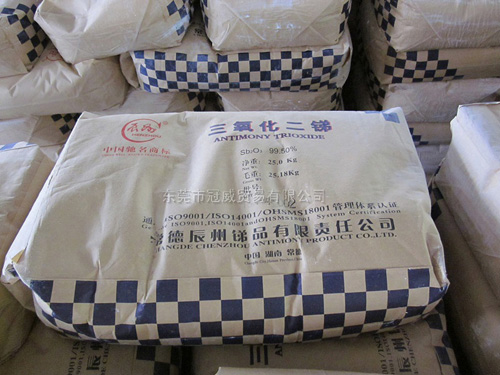


Click to view the SGS certificate for antimony trioxide
Click to view the MSDS details for antimony trioxide
Click to view the electron microscope images of antimony trioxide
Antimony Trioxide| Grade | Sb2O3 | PbO | CuO | As2O3 | Fe2O3 | Se | Cd |
| Standard Grade | ≥99.8% | ≤0.05% | ≤0.0015% | ≤0.05% | ≤0.003% | ≤0.0008% | ≤0.0005 |
| Melting Point | 656℃ |
| Boiling Point | 1425℃ |
| Density | 5.2 |
| Whiteness | 90 degrees |
| Fineness | 0.4~1.2μm |
| Molecular Weight | 291.6 |
| CAS No. | 1309-64-4 |
1. Used by plastic processors as a synergistic flame retardant in thermoplastic and thermoset formulations, with end uses in transportation, construction and structural materials, electrical appliances, wires and cables, and furniture in industrial sectors;
2. Used by rubber processors in rubber products that require flame retardancy, such as rubber hoses, belts, carpet backing, and other rubber goods;
3. Used by automobile manufacturers in PVC seat covers, carpets, and other rubber components inside or under car hoods;
4. Used by synthetic fiber producers indirectly as a processing catalyst; antimony oxide plays an important role in the esterification of polyethylene terephthalate resins and fibers;
5. Used by glass manufacturers as an oxidation-reduction clarifying agent; in the glass coloring process, antimony oxide reduces some metals (including iron, manganese, and chromium), lowering their valence to achieve stronger glass colors;
6. Used by ceramics and glaze producers as a bright, transparent white coloring agent embedded in glass or oil materials; this coloring agent is widely used in enameled cast iron bathtubs;
7. Used by paint manufacturers for flame retardant white colors, and when combined with other metals, it forms yellow colors 41, 53, and 118;
8. Used by paper product manufacturers as an essential component in flame-retardant papers, which can be used for household insulation products;
9. Used by chemical producers to make a special heat stabilizer (thiol antimony) for PVC, recognized by the FDA; also used as an intermediate in organic and inorganic compounds, and by phosphor lamp manufacturers to activate calcium halophosphate phosphor;
10. Used by solid lubricant manufacturers as a synergist for molybdenum disulfide, playing a role in aerospace lubrication.

